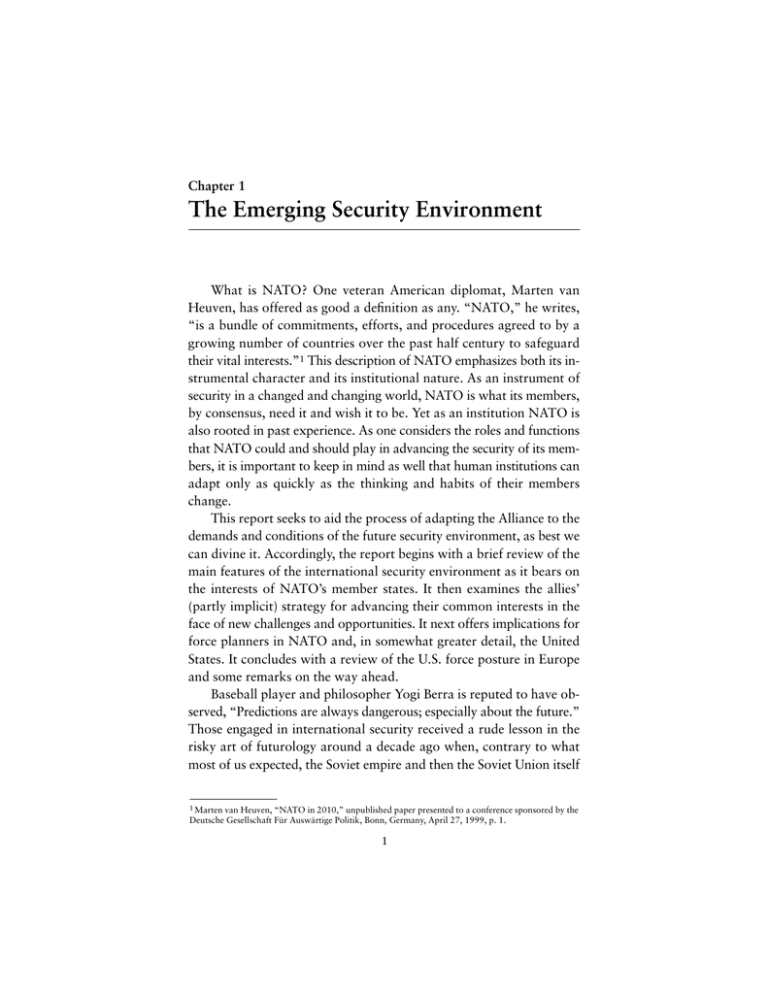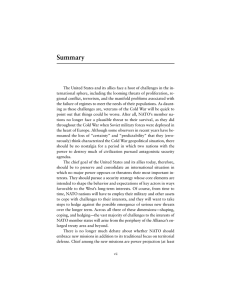The Emerging Security Environment
advertisement

Chapter 1 The Emerging Security Environment What is NATO? One veteran American diplomat, Marten van Heuven, has offered as good a definition as any. “NATO,” he writes, “is a bundle of commitments, efforts, and procedures agreed to by a growing number of countries over the past half century to safeguard their vital interests.”1 This description of NATO emphasizes both its instrumental character and its institutional nature. As an instrument of security in a changed and changing world, NATO is what its members, by consensus, need it and wish it to be. Yet as an institution NATO is also rooted in past experience. As one considers the roles and functions that NATO could and should play in advancing the security of its members, it is important to keep in mind as well that human institutions can adapt only as quickly as the thinking and habits of their members change. This report seeks to aid the process of adapting the Alliance to the demands and conditions of the future security environment, as best we can divine it. Accordingly, the report begins with a brief review of the main features of the international security environment as it bears on the interests of NATO’s member states. It then examines the allies’ (partly implicit) strategy for advancing their common interests in the face of new challenges and opportunities. It next offers implications for force planners in NATO and, in somewhat greater detail, the United States. It concludes with a review of the U.S. force posture in Europe and some remarks on the way ahead. Baseball player and philosopher Yogi Berra is reputed to have observed, “Predictions are always dangerous; especially about the future.” Those engaged in international security received a rude lesson in the risky art of futurology around a decade ago when, contrary to what most of us expected, the Soviet empire and then the Soviet Union itself 1 Marten van Heuven, “NATO in 2010,” unpublished paper presented to a conference sponsored by the Deutsche Gesellschaft Für Auswärtige Politik, Bonn, Germany, April 27, 1999, p. 1. 1 2 NATO’S FUTURE: IMPLICATIONS FOR U.S. MILITARY CAPABILITIES AND POSTURE disintegrated—developments whose repercussions continue to alter the strategic landscape. The dangers of prediction notwithstanding, several fairly clear trends discernable now can help guide strategy and planning over the coming decade. First, we can all but rule out the possibility that Russia will pose a significant, direct military threat to NATO over this period. This finding stands almost regardless of the eventual outcome of the social and political turmoil that the country is now experiencing. Modern military forces are expensive. They are also institutions that grow out of the societies whose interests they are meant to protect. Thus, a return to economic growth and a modicum of societal stability are necessary precursors to resurrected Russian military power. For this power to constitute a threat to the West, it would have to be wielded by a regime that viewed its interests as antithetical to our own, at least in some important respects. It is an open question whether these three requisites—economic success, social stability or mobilization, and antiWestern orientation—can once again coexist in post–Soviet Russia. However, it seems clear that they will not emerge there together and on a sustained basis any time soon. Of course, Russia is the custodian of the world’s second most powerful arsenal of nuclear weapons. For Russia, however, it seems that these weapons will be useful primarily as a guarantee against aggression rather than as an instrument of coercion. And while the United States and its allies will be compelled to devote substantially greater resources than now to capabilities for defeating weapons of mass destruction and their delivery vehicles, this imperative will be driven less by Russian nuclear capabilities and more by concerns over regional actors with expansionist or messianic objectives and antiWestern ideologies. That said, a Russia ruled by elements that perceive reform and Westernization as somehow antithetical to their interests could cause significant problems for the United States and its NATO allies. Moscow could, for example, accelerate the spread of weapons of mass destruction and other sensitive military technologies through irresponsible export policies (or ineffectual export controls). Russia could also intervene in the politics of neighboring states in the Caucasus, Caspian, and THE EMERGING SECURITY ENVIRONMENT 3 Central Asian regions in attempts to limit Western influence and undermine stability there. In addition, by wielding its veto in the United Nations Security Council or in other ways, Russia could play a spoiler’s role, complicating or preventing efforts by the international community to promote common objectives through cooperative action. The challenge for the West, then, is to try to keep Russia on a generally reformist path while continuing to support the independence and stability of Russia’s neighboring states. Pending the emergence of a truly reformist, stable, and Western-oriented government in Moscow, this will require a careful balancing act, because some elements in Russia will continue to take a dim view of Western support to newly independent states on the Russian periphery. Central Europe, by contrast, is becoming more stable. NATO’s embrace of Poland, Hungary, and the Czech Republic is only one factor in this welcome development. Like several other states in the region (most notably, the Baltics), NATO’s new members have energetically pursued reformist economic agendas within the framework of democratic political systems. The transition to open markets and pluralist politics has not been painless or risk-free for these countries, but the benefits are beginning to become manifest. The West’s objectives here are to help sustain these trends by broadening and deepening the links (both informal and institutional) between these post-Communist success stories and the West. Assuming a continuation of favorable trends in central Europe, the most pressing security challenges facing NATO will come from the Balkans and beyond Europe. The conflict over the status of Kosovo is only the most recent example of the ways in which the explosive cocktail of unreconciled ethnic or religious enmities, intermingled populations, and anti-democratic demagoguery can flare up into disputes that offend Western values and threaten Western interests. Put simply, large-scale, sustained, and Western-led intervention may still be required to help the peoples of the Balkans resolve the multiple conflicts dividing them. Montenegro, Macedonia, and Albania loom as potential flash points beside the tragedies that have been played out in Kosovo and that remain just beneath the surface in Bosnia. The major uncertainties relating to the Balkans are, first, the costs that Western 4 NATO’S FUTURE: IMPLICATIONS FOR U.S. MILITARY CAPABILITIES AND POSTURE governments will be willing to bear to try to stabilize the situation, and, second, the longevity of the Milosevic regime and the nature of the government that follows it. The Balkans, in short, provide a test of the extent to which NATO’s members are prepared to use their military forces (as well as their limited economic and diplomatic resources) in operations that aim to redress situations that threaten common yet rather amorphous interests. The Balkans are also a factor hastening the evolution of the Alliance toward a future in which out-of-area peace enforcement operations are seen—by its members and, increasingly, by the broader international community—as an accepted part of the Alliance’s raison d’etre.2 Europe’s southeastern periphery is another source of security concerns, especially because most of the military contingencies for which NATO actively plans are located in the southeast—especially around Turkey. The ongoing dispute between Greece and Turkey is just one of a number of possible conflicts that could involve Turkey, a country that shares borders with Syria, Iraq, and Iran, among others. Increasingly, the security of Europe (like that of the United States) is intertwined with situations in the Middle East and Eurasia. Iraq, Iran, Libya, and others have shown a determination to acquire weapons of mass destruction and the means to deliver them over increasing distances. At the same time, Europe and the West generally will remain heavily dependent on imported oil and gas, largely from the Persian Gulf. The growing ease and volume of international travel and trade are making it harder to protect against the spillover effects of violence in other nations or regions, whether these effects be “exported” deliberately by terrorists or inadvertently through large-scale migration by the victims of violence or state failure. Further afield, the newly independent republics along Russia’s southern border, as well as territories within Russia itself, are weak and unstable. These states face serious internal and intraregional threats to their stability and security, including regional, tribal, ethnic, and clan 2 Not that many decisionmakers in NATO capitals are eager for another test similar to Operation Allied Force. Indeed, the searing experience of trying to coerce Milosevic to cease his depredations against the Kosovar Albanians will likely prompt great caution the next time such a challenge arises. Nevertheless, few question either that NATO was right to intervene when it did or that the allies must work to improve their capabilities for such military operations in the future. THE EMERGING SECURITY ENVIRONMENT 5 disputes; economic hardships; immature political institutions, civil societies, and national identities; potential conflicts over land, water, energy, and mineral resources; and pervasive corruption, crime, and cronyism. In short, the Caucasian, Caspian, and Central Asian states generally suffer from the usual problems of weak states. Thus, the possibility cannot be ruled out that one or more of them could lose the capacity to maintain order and govern effectively. Although the West does not have vital interests in the region, it does have a stake in the success of reform there and in assured access to the region’s resources. Hence, crises and instabilities there could engender pressure for intervention by NATO forces, either to monitor or to enforce a settlement of disputes.3 3 For an analysis of NATO’s interests in this region and challenges to them, see Richard Sokolsky and Tanya Charlick-Paley, NATO and Caspian Security: A Mission Too Far? RAND, MR-1074-AF, 1999.








